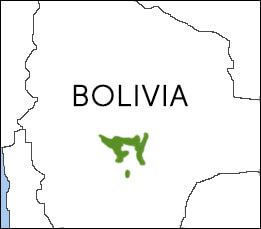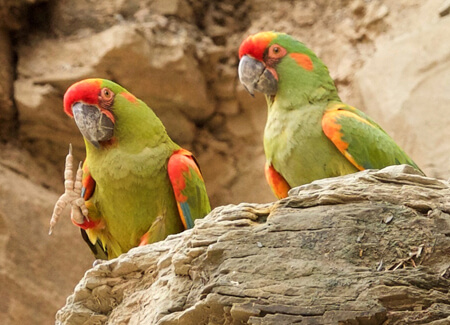 Found only in dry scrub forests of Bolivia, the handsome Red-fronted Macaw was adopted as a regional symbol of pride and identity in 2012, and now decorates official government vehicles and buildings.
Found only in dry scrub forests of Bolivia, the handsome Red-fronted Macaw was adopted as a regional symbol of pride and identity in 2012, and now decorates official government vehicles and buildings.
Despite this increase in local awareness, this large parrot — like other macaws, including the Lear's, Blue-throated, and Military — is still in high demand by the illegal pet trade. Other threats include habitat loss, persecution as a crop pest, and contamination by pesticides applied to crops.
Cliff-dweller and Cactus Disperser
Since natural tree cavities are scarce in its habitat, the Red-fronted Macaw nests on steep-sided river cliffs. Its diet includes seeds and fruit, particularly cactus fruit, which provide both nourishment and moisture in its arid habitat. The macaws in turn serve as an effective seed disperser for the cacti.
Unfortunately, native food sources are often scarce because of habitat destruction for agriculture, grazing, or firewood. This leads the birds to feed extensively on cultivated crops, particularly corn, sometimes resulting in persecution by farmers.
Sign up for ABC's eNews to learn how you can help protect birds
Red-fronted Macaws form monogamous bonds with their mates and maintain them year-round. Adults and their young remain on the breeding grounds until May, then congregate in a few large flocks in agricultural areas.

Red-fronted Macaws by Shoaib Tareen
Like other parrots, they are highly social and fly, forage, and roost in groups of up to 30 individuals.
Steps to Save the Red-fronted Macaw
With support from ABC, local partner Asociación Armonía established the 120-acre Red-fronted Macaw Nature Reserve to protect the largest known breeding colony of the species. An ecotourism lodge opened in 2006 with proceeds going to the local communities.
ABC and Armonía continue working together to reduce persecution and illegal trafficking of Red-fronted Macaws, which remains their greatest threat.
In cooperation with other partners, local communities, and municipalities, ABC has also helped designate two areas totaling 500,000 acres, in the heart of the Red-fronted Macaw's range, where agricultural development, timber extraction, and hunting are restricted.
Donate to support ABC's conservation mission!



















































